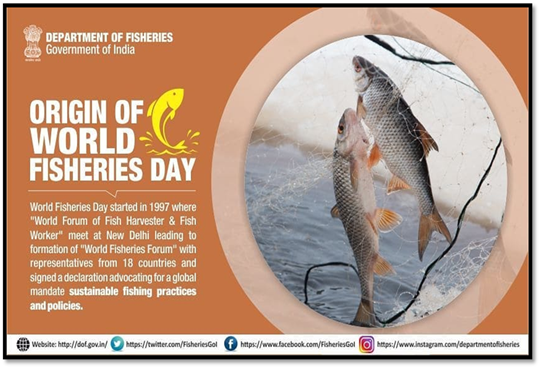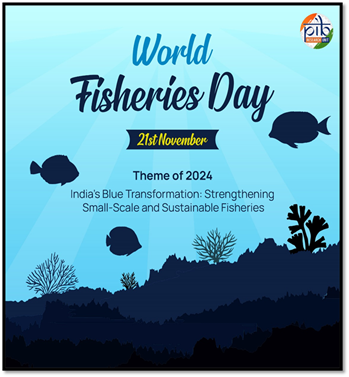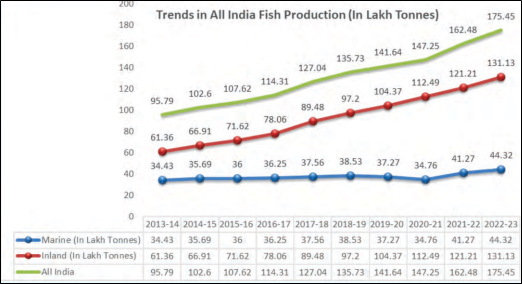Others
World Fisheries Day
Sustainable Fishing Practices for a Thriving and Eco-Friendly Fisheries Sector
Posted On:
20 NOV 2024 5:57PM
“To me the Blue Chakra or wheel in India’s national flag represents the potential of Blue Revolution or the Ocean Economy. That is how central the ocean economy is to us.”
-Prime Minister Narendra Modi
Overview
World Fisheries Day, observed every November 21st, is a global event that underscores the critical importance of sustainable fisheries and the need to protect aquatic ecosystems and the livelihoods of fishing communities.

The Day originated in 1997 when the "World Forum of Fish Harvesters & Fish Workers" convened in New Delhi. During this meeting, representatives from 18 countries came together to establish the "World Fisheries Forum" and signed a declaration advocating for adopting sustainable fishing practices and policies worldwide. The day raises awareness about the various threats facing the world’s fisheries, including overfishing, habitat destruction, and illegal fishing practices, while also advocating for the rights of small-scale fishers, who are often among the most marginalized and vulnerable groups worldwide.
In India, World Fisheries Day takes on special significance, given the country's vital role in global fisheries and aquaculture. As the 3rd largest fish producer, 2nd largest aquaculture nation in the world after China and the largest producer of shrimp, India contributes significantly to both domestic food security and the global seafood market.
The Indian fisheries sector not only supports the livelihoods of around 30 million people, especially in coastal and rural communities, but it also holds immense potential for growth, job creation, and rural development. In recent years, Indian fisheries have experienced a significant shift, moving from a marine-dominated sector to a greater focus on inland fisheries. The contribution of inland fisheries to total fish production has risen dramatically in India Within this shift, there has been a notable transition from capture fisheries to culture-based (or aquaculture) practices, which has played a key role in driving the growth of a sustainable blue economy.
On World Fisheries Day, India joins the global call for action to promote sustainable fisheries practices, protect marine environments, and empower fishing communities, reinforcing its leadership in the sector and its dedication to safeguarding the future of global seafood production
India Celebrates World Fisheries Day 2024
 The Department of Fisheries (DoF) under the Ministry of Fisheries, Animal Husbandry and Dairying is set to celebrate World Fisheries Day (WFD) on 21st November 2024. This year’s World Fisheries Day 2024 theme is India’s Blue Transformation: Strengthening Small-Scale and Sustainable Fisheries. The event will be hosted by the DoF on 21st November 2024 at Sushma Swaraj Bhawan, New Delhi, in the presence of the Union Minister, Ministry of Fisheries, Animal Husbandry & Dairying (MoFAH&D) and Ministry of Panchayati Raj, Shri Rajiv Ranjan Singh alias Lalan Singh.
The Department of Fisheries (DoF) under the Ministry of Fisheries, Animal Husbandry and Dairying is set to celebrate World Fisheries Day (WFD) on 21st November 2024. This year’s World Fisheries Day 2024 theme is India’s Blue Transformation: Strengthening Small-Scale and Sustainable Fisheries. The event will be hosted by the DoF on 21st November 2024 at Sushma Swaraj Bhawan, New Delhi, in the presence of the Union Minister, Ministry of Fisheries, Animal Husbandry & Dairying (MoFAH&D) and Ministry of Panchayati Raj, Shri Rajiv Ranjan Singh alias Lalan Singh.
The inaugural session of World Fisheries Day (WFD) 2024 will focus on launching several key initiatives to promote sustainable fisheries and aquaculture. These include the 5th Marine Fisheries Census for data-driven policymaking, the National Plan of Action (NPOA) on Sharks for shark conservation, and the Bay of Bengal-Regional Plan of Action (BoB-RPOA) to combat illegal, unreported, and unregulated (IUU) fishing. Other initiatives include the IMO-FAO GloLitter Partnership Project to tackle marine plastic pollution and the launch of Standard Operating Procedures for retrofitted LPG kits to encourage energy-efficient fishing practices.
Additionally, the Coastal Aquaculture Authority will introduce a New Single Window System for online registration of coastal aquaculture farms, and a Memorandum of Understanding (MoU) will be signed to establish a Voluntary Carbon Market framework in the fisheries sector. Progressive States/UTs, individuals, and entrepreneurs will also be honoured for their contributions to the growth of Indian fisheries and aquaculture.
Two technical sessions will take place: the first will address South-South and Triangular Cooperation for sustainable fisheries and food security, and the second will discuss the challenges of climate change in fisheries and potential mitigation strategies. These sessions will explore future opportunities for sustainable development, including carbon credits, plastic management, and traceability in the fisheries sector. WFD 2024 aims to foster partnerships, promote best practices, and create awareness about the achievements and untapped potential within the fisheries sector.[1]
India’s Role in Global Fisheries: Key Facts and Achievements
- Position in Global Fisheries and Aquaculture
 India’s fisheries sector is a key player on the global stage, with the Blue Revolution highlighting the critical importance of fisheries and aquaculture in the country. Recognized as a "sunrise sector," it is poised to make a significant contribution to the Indian economy in the near future, driven by its vast potential for growth and development. As the 3rd largest fish producer, it is an integral part of the global food system. The country is also the 2nd largest aquaculture nation, contributing significantly to the world’s shrimp and fish supply.[2]India is the world leader in shrimp production, a critical component of its seafood exports. The sector’s continued growth supports both domestic consumption and international markets, where India has become a significant exporter.
India’s fisheries sector is a key player on the global stage, with the Blue Revolution highlighting the critical importance of fisheries and aquaculture in the country. Recognized as a "sunrise sector," it is poised to make a significant contribution to the Indian economy in the near future, driven by its vast potential for growth and development. As the 3rd largest fish producer, it is an integral part of the global food system. The country is also the 2nd largest aquaculture nation, contributing significantly to the world’s shrimp and fish supply.[2]India is the world leader in shrimp production, a critical component of its seafood exports. The sector’s continued growth supports both domestic consumption and international markets, where India has become a significant exporter.
In addition to shrimp, India produces a wide range of fish, including carps, catfish, and tilapia, which are vital to the global food supply chain. India’s fisheries sector is also a major contributor to food and nutritional security, both within the country and internationally.
- Growth in Fish Production
India’s fish production has witnessed remarkable growth over the years. Initially dominated by marine fish production, the sector has seen a significant shift towards inland fisheries, which now contributes around 70% of the country’s total fish production. This transformation has been driven by the adoption of science-based fisheries management practices and the holistic approach under the Pradhan Mantri Matsya Sampada Yojana (PMMSY), which focuses on optimal utilization of resources, technology infusion, and capacity building.
A key contributor to this growth is the culture-based fishery in India’s vast network of tanks and ponds, which cover approximately 2.36 million hectares. The government is investing in expanding rearing and grow-out pond areas, as well as diversifying species and adopting sustainable aquaculture practices. The PMMSY has sanctioned numerous projects, to further boost production and improve productivity from 3 tonnes per hectare to 5 tonnes per hectare.
Brackish and saline aquaculture has also seen significant growth, particularly in shrimp farming, which has become a major contributor to India’s seafood export earnings. India has around 1.42 million hectares of brackish/saline areas, though only about 13% is currently utilized.[3]
Additionally, India is focusing on the development of saline water aquaculture, aiming to convert wastelands into productive aquaculture zones. States like Haryana, Punjab, Rajasthan, and Uttar Pradesh, with high soil salinity, are being promoted for saline water aquaculture.
Cold water fisheries, particularly in the Himalayan states, offer another promising avenue for growth. Cold water fisheries also have the potential to generate significant employment opportunities and contribute to niche markets, particularly for omega-rich trout, which is being promoted as a high-value product across the Himalayan region.
Growing Investment in the Fisheries Sector
The Department of Fisheries received a historic Rs. 2,584.50 crore allocation for FY 2024-25, marking a 15% increase in the annual budget. This funding will support the implementation of the PMMSY, FIDF, and other developmental schemes aimed at promoting sustainable and responsible fisheries practices.
Since the First Five-Year Plan, the expenditure on the fisheries sector was Rs. 3,680.93 crore. However, from 2014-15 to 2023-24, a total of Rs. 6,378 crore has been allocated for various fisheries development activities. Over the last nine years, the targeted investment in the sector has exceeded Rs. 38,572 crore, marking the highest-ever investment in this growing sector.[4]
Government Initiatives and Schemes to Promote Sustainable Fisheries
- Blue Revolution Integrated Development and Management Fisheries Scheme or Blue Revolution Scheme was launched in FY2015-16. The scheme primarily focused on increasing fish production and productivity.
- Pradhan Mantri Matsya Sampada Yojana (PMMSY)
The Pradhan Mantri Matsya Sampada Yojana (PMMSY), launched in May 2020, is a flagship initiative aimed at transforming India’s fisheries sector.
 The scheme focuses on enhancing aquaculture productivity, improving fisheries management, and creating 55 lakh new jobs in the sector, along with big infrastructural changes of establishing five integrated aquaparks. It also envisages doubling fisheries exports to 1 lakh crores. One of the central goals of PMMSY is to increase aquaculture productivity, which currently stands at 3 tonnes per hectare (Ha), to 5 tonnes per hectare. It also aims to improve fish farming infrastructure and reduce seafood production waste. In addition to these, the scheme strongly focuses on sustainable practices, ensuring that growth in the sector is achieved without compromising environmental integrity.
The scheme focuses on enhancing aquaculture productivity, improving fisheries management, and creating 55 lakh new jobs in the sector, along with big infrastructural changes of establishing five integrated aquaparks. It also envisages doubling fisheries exports to 1 lakh crores. One of the central goals of PMMSY is to increase aquaculture productivity, which currently stands at 3 tonnes per hectare (Ha), to 5 tonnes per hectare. It also aims to improve fish farming infrastructure and reduce seafood production waste. In addition to these, the scheme strongly focuses on sustainable practices, ensuring that growth in the sector is achieved without compromising environmental integrity.
- Fisheries and Aquaculture Infrastructure Development Fund (FIDF)
The Fisheries and Aquaculture Infrastructure Development Fund (FIDF) was introduced in 2018-19 to provide funding for the creation of infrastructure in both marine and inland fisheries. FIDF loans can cover up to 80% of the project cost, with interest subvention of up to 3%. This financial support is essential for fish farmers, entrepreneurs, and cooperatives looking to improve the infrastructure required to scale up production.
- ICAR-Central Institute of Fisheries Education (CIFE): A Centre of Excellence
Institutional Development and Mission:
The Central Institute of Fisheries Education (CIFE), established in 1961, is India’s leading institution for higher education and research in fisheries. CIFE has trained more than 4,000 fisheries extension workers and professionals who play a crucial role in promoting sustainable fisheries practices across the country. CIFE’s role in capacity building has been critical to the growth of India’s fisheries sector. By providing technical expertise and scientific knowledge, CIFE has helped improve fish production methods, reduce waste, and develop innovative solutions for sustainable aquaculture. Additionally, the institute conducts applied research on fish health, aquatic nutrition, and sustainable fish farming practices, helping the sector adapt to new challenges.
Promoting Sustainable Fishing in India: Safeguarding Marine Resources for the Future
India's commitment to sustainable fisheries management is reflected in its comprehensive approach to regulating and conserving marine resources, particularly within its territorial waters and Exclusive Economic Zone (EEZ). The subject of fisheries within the 12 nautical miles from the coast falls under the 'State list' of the Constitution, with the coastal states and Union Territories (UTs) enacting the Marine Fishing Regulation Act (MFRA) to manage and regulate fishing activities.
Key highlights of India's sustainable fishing efforts include:
National Policy on Marine Fisheries (NPMF, 2017): The Government of India has introduced the NPMF, which places a strong emphasis on sustainability as the core principle for all marine fisheries actions. This policy guides the conservation and management of India’s marine fishery resources.
Regulation and Conservation Measures: To ensure the long-term sustainability of marine fish stocks, the Government has implemented several conservation measures, including:
- Uniform Fishing Ban: A 61-day uniform fishing ban during the monsoon season in the EEZ to allow fish stocks to replenish.
- Prohibition of Destructive Fishing Methods: Bans on pair trawling, bull trawling, and the use of artificial LED lights in fishing, which help reduce overfishing and minimize damage to marine ecosystems.
- Promotion of Sustainable Practices: Encouraging sea ranching, the installation of artificial reefs, and mariculture activities such as seaweed cultivation.
- Fisheries Regulations by States/UTs: Coastal States/UTs have also implemented gear-mesh size and engine power regulations, minimum legal size (MLS) of fish, and zonation of fishing areas for different types of vessels, contributing to sustainable fishing.[5]
Conclusion
As India continues to strengthen its fisheries sector, it will not only help meet the growing global demand for seafood but also contribute to the economic empowerment of millions of fishers and fish farmers, fostering a sustainable and inclusive growth model for the future. The collaboration between the government, scientific institutions like ICAR-CIFE, and global initiatives will be instrumental in ensuring that India remains at the forefront of the global push for responsible and sustainable fisheries practices.
In conclusion, with its robust policy framework, increased investments, and a clear focus on sustainability, India’s fisheries sector is poised to play a leading role in securing the future of global food systems and ecosystems while providing economic empowerment to its fishing communities.
Reference:
https://www.internationaldays.org/november/world-fisheries-day
https://pib.gov.in/PressReleaseIframePage.aspx?PRID=1977356
https://pib.gov.in/PressReleaseIframePage.aspx?PRID=1877452
https://www.cife.edu.in/
https://pib.gov.in/PressReleaseIframePage.aspx?PRID=2001498
https://pib.gov.in/PressReleaseIframePage.aspx?PRID=1674522
https://incois.gov.in/documents/Blue_Economy_policy.pdf
https://pib.gov.in/PressReleaseIframePage.aspx?PRID=2074882.
https://www.pib.gov.in/PressNoteDetails.aspx?NoteId=152138&ModuleId=3®=3&lang=1
Click here to see in PDF:
Santosh Kumar/Ritu Kataria/ Ishita Biswas
(Backgrounder ID: 153438)
Visitor Counter : 4281
Provide suggestions / comments